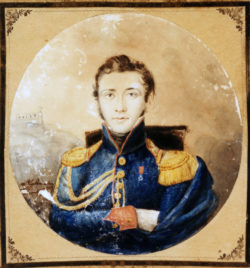Benjamin Buisson
Pierre Benjamin Buisson was a talented architect, engineer, surveyor, and publisher, was born in Paris, France, and migrated to New Orleans while in his early twenties where he advanced his career with work on major public buildings.

Courtesy of Louisiana State Museum
Pierre Benjamin Buisson. Unidentified
Pierre Benjamin Buisson, a talented architect, engineer, surveyor, and publisher, was born in Paris, France, and migrated to New Orleans while in his early twenties, where he advanced his career with work on major public buildings. He was born on May 20, 1793, the son of Jean-Francoise-Claude Buisson and Marie Esther Guillotte. He was appointed to l’Ecole Polytechnique (the French military college) in Paris in 1811 for training in engineering, artillery, applied geometry, and mathematics. Like many of his fellow students, Buisson joined the armies of Napoleon, serving as a lieutenant in the Sixth Artillery of the Grand Army of France. He fought through the 1814 and 1815 campaigns, winning the Legion of Honor and the St. Helena Medal. Napoleon’s defeat at the Battle of Waterloo in 1815 prompted Buisson to visit relatives in New Orleans in 1817, where he soon established himself professionally and in 1820 married Sophie Guillotte, with whom he had six children. A watercolor in the Louisiana State Museum shows the young Buisson wearing his elaborate French uniform adorned by a treasured Cross of the Legion of Honor. He soon put his military training to work organizing a corps of cannoneers for the Louisiana Legion in 1824.
One of his first commissions was the 1819 design of a rather plain customhouse to replace the smaller, deteriorating structure designed by Benjamin Latrobe nearly a decade earlier. That same year, Buisson vied with Latrobe for a contract to add a steeple to St. Louis Cathedral, but church wardens selected the better-known architect. Later in his career, in 1835, Buisson made repairs and additions to the State House (900 Canal Street) amounting to $9,250. He designed a $12,000 jail for Jefferson Parish in 1836, and planned a jail in Faubourg Bouligny in 1848. In 1840, he made repairs and additions to the Presbytere on Jackson Square, then used as a courts building.
During the 1820s, Buisson began a career in publishing and writing. His publications include the Courrier des Natchitoches (1824–1827), a bilingual newspaper in Natchitoches, Louisiana; the Journal de Commerce (1825–1829) in New Orleans; and a bilingual textbook on civil procedure. Buisson authored an astronomy text, Des Forces qui régissent le système solaire (1849), and a military manual, Instruction pour le service et manoeuvre de l’infanterie légère (1861).
Buisson made his greatest contribution to New Orleans as a surveyor. In 1832, developers of a large plantation upriver of the city selected Buisson to create the Faubourg Livaudais, soon to form a large part of the city of Lafayette. The plan was a simple grid extending from about First to Harmony Streets and from the river to LaSalle Street, encompassing the core of today’s Garden District and portions of other neighborhoods.
As surveyor of New Orleans from 1832 until 1855, he drew plans for suburbs further upriver that ultimately were annexed into the city, including the Faubourg St. Joseph (extending from the river between Amelia and General Taylor Streets) and Rickerville (between Valmont and Joseph Streets) in 1849. Faubourg Bouligny (between General Taylor and Upperline Streets) constitutes a large part of Uptown New Orleans, and its layout is generally credited to Buisson, although deputy surveyor Charles F. Zimpel signed the 1832 map. Buisson named the streets. According to James Beard, writing in the Daily Picayune of 1911, “As might be expected, the names reflect the history of the man whom all his life he most admired, his general and emperor, Napoleon. Many of the streets are named for battles, such as Milan, Berlin, Cortez [sic Cadiz], Jena, etc.” Of similar inspiration are streets named for other sites associated with the famous French leader: Marengo, Constantinople, Lyons, Bordeaux, and Valence Streets, with the widest and most important boulevard called Napoleon Avenue. Buisson utilized a simple grid plan within the tapering triangles necessitated by old plantation divisions. An 1857 fire at the surveyor’s office destroyed most of his plans and surveys. According to his successor, William H. Williams, among the lost papers was a volume containing “the records of numerous surveys made by Mr. B. Buisson as Parish Surveyor.”
In his capacity as surveyor, he also designed and supervised public works projects, such as rebuilding with cypress piles a 2,200-foot stretch of the Mississippi River levee between First and St. Andrew Streets. By 1860, with the approach of war with the Union, Buisson offered his services to the Confederate States of America and was appointed brigadier general, serving on the Committee on City Defense. In 1861, he designed a breastworks and powder magazine in Jefferson Parish, and, although the project was undertaken by others, it is probable that his experience and engineering background played a large part in the work. He also planned an artillery emplacement near the town of Lafitte. In spite of such preparations, New Orleans fell to federal forces in 1862. Buisson was then in command of the 22nd Louisiana Volunteers.
Buisson died on May 30, 1874. His lengthy obituary in the New Orleans Bee/L’Abeille newspaper hailed him as a person of irreproachable honesty and spotless loyalty who enjoyed great popularity. While respected during his lifetime, Benjamin Buisson is little remembered today, although the streets he planned and named constitute a large portion of Uptown New Orleans.
